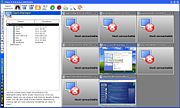- Intelligent Teaching And Learning with Computers
-
iTALC
iTALC (Intelligent Teaching And Learning with Computers) est un logiciel libre d'e-learning permettant à un professeur de prendre la main pour effectuer des démonstrations sur les postes des étudiants dans une salle de cours informatisée mise en réseau.
Le programme a été développé comme alternative libre du logiciel MasterEye en utilisant la bibliothèque Qt.
Des versions du logiciel existent pour Linux et pour Windows. iTALC fonctionne même dans un environnement hétérogène. Par exemple, un professeur possédant un portable fonctionnant sous Linux peut parvenir à administrer un réseau sous Windows.
A la base de toutes les fonctions il y a le protocole "Remote Frame Buffer" (RFB) étendu. Il s'agit d'un protocole simple pour l'accès à distance aux interfaces graphiques des utilisateurs. iTALC travaille entièrement avec des connexions TCP, ce qui a l'avantage que les démos et les administrations à distance sont possibles par dessus les pare-feux locaux.
Sommaire
Installation
L'installation du client maitre de iTALC se fait sur un poste "maitre" (ou éventuellement plusieurs si on veut changer de place dans la classe).
Le déploiement du client "élèves" doit être fait sur le reste des postes.
La sécurité, pour éviter que des intrus ne prennent la main se l'extérieur de la classe, est assurée grâce à une clé que les postes "élèves" doivent récupérer auprès du poste "maitre".Notes et références
Lien externe
- site du constructeur,
- description de iTALC sur le site du projet collaboratif sur le logiciel libre framasoft,
- Guide d'installation et de prise en main, en français, script de mise à jour automatique, sur le site PRTICE.INFO
Voir aussi
Logiciels libres similaires :
- Tkontrole Site
Logiciels propriétaires concurrents :
- NetOp School de Danware,
- NetSupport School de AmosdecSite,
- MasterEye de Genevalogic Site,
- Portail des logiciels libres
- Portail de l’éducation
Catégories : Logiciel sous licence libre | Tice
Wikimedia Foundation. 2010.

